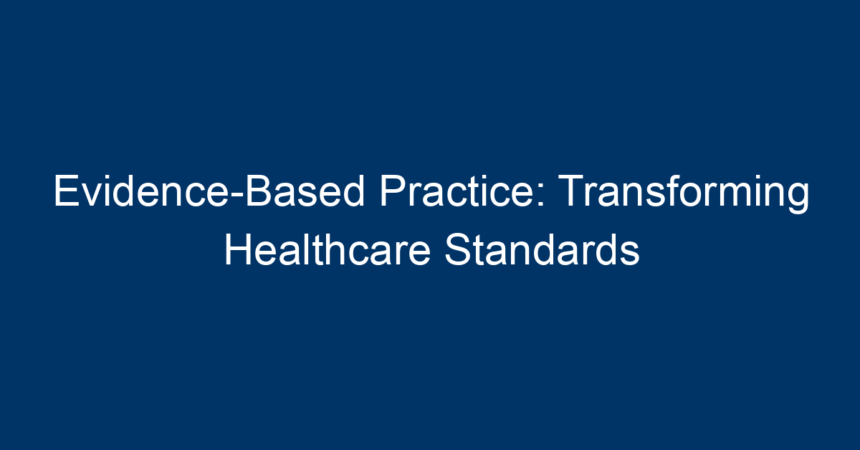In today’s rapidly evolving healthcare landscape, the pursuit of improved patient outcomes and satisfaction is more critical than ever. One of the most effective means to achieve these goals is through evidence-based practice (EBP). This approach integrates the best available research with clinical expertise and patient values, fostering a more effective and standardized method of care. This article delves into the fundamentals of evidence-based practice, its significance, and its transformative effect on healthcare standards.
What Is Evidence-Based Practice?
Evidence-based practice is a systematic approach to decision-making in healthcare that emphasizes the use of current, high-quality research to guide clinical decisions. It’s built around three core elements:
- Best available evidence: This includes recent clinical research, randomized controlled trials, expert opinions, and even case studies.
- Clinical expertise: Healthcare professionals use their knowledge and skills to assess and apply research findings effectively in real-world scenarios.
- Patient values and preferences: Understanding the unique preferences and needs of patients ensures that care is tailored and effective.
EBP aims not just to apply the best treatments but to consider the whole person in the context of their care.
The Importance of Evidence-Based Practice in Healthcare
1. Improved Patient Outcomes
The primary goal of evidence-based practice is to enhance patient care. By utilizing high-quality research, healthcare providers can deliver interventions that are proven to be effective. Numerous studies have shown that implementing EBP leads to:
- Reduced complications: Evidence-based interventions can minimize risks associated with surgical procedures and other treatments.
- Faster recovery times: Patients often recover quicker when treated with practices that have been shown to work through rigorous studies.
2. Enhanced Healthcare Efficiency
Incorporating EBP into healthcare practices can also streamline processes, thus improving efficiency. By relying on proven strategies, clinicians can avoid unnecessary tests and treatments that may be costly and time-consuming. This not only benefits the healthcare system by reducing waste but also alleviates the financial burden on patients.
3. Increased Patient Satisfaction
Patients are more likely to be satisfied with their care when it aligns with their values and preferences. EBP encourages shared decision-making, allowing healthcare providers to involve patients actively. This collaboration fosters trust and transparency, which can greatly enhance the patient experience.
Key Components of Implementing Evidence-Based Practice
Implementing evidence-based practice requires a structured approach. Here are the essential components:
1. Formulating a Clear Clinical Question
The foundation of EBP lies in defining a relevant clinical question. Using frameworks like the PICOT model (Population, Intervention, Comparison, Outcome, Time) can help clinicians articulate their inquiry and guide the research process.
2. Conducting Thorough Research
Once a clinical question is posed, the next step is to gather evidence. Systematic reviews, meta-analyses, and clinical guidelines from reputable sources (e.g., Cochrane Library, PubMed) can provide a wealth of information.
3. Appraising the Evidence
Not all research is created equal. Clinicians must critically evaluate the quality and applicability of the findings. Assessing the methodology, sample size, and relevance to the specific patient population is essential in determining whether the evidence should influence practice.
4. Deciding on an Intervention
In this stage, healthcare providers synthesize their findings with their clinical expertise and the patient’s individual values and needs. This collaborative process often results in more personalized care plans.
5. Evaluating the Outcomes
After implementing the chosen intervention, it’s crucial to monitor and evaluate the results. This ongoing assessment can provide valuable feedback, driving improvements in future practices.
6. Disseminating Findings
Sharing outcomes and insights gathered through EBP can help build a culture of learning within healthcare organizations. By disseminating this knowledge, practitioners can contribute to the overall body of evidence that informs future healthcare standards.
Barriers to Implementing Evidence-Based Practice
Despite its many benefits, there are several barriers to implementing EBP in healthcare settings:
1. Knowledge Gaps
Many healthcare professionals lack formal training in EBP. Continuous education and workshops focused on research methods can help bridge this gap.
2. Resistance to Change
Change can be daunting, especially in established healthcare settings. Clinicians may have entrenched practices based on tradition as opposed to evidence. Effective leadership and ongoing support can facilitate a smoother transition towards EBP.
3. Limited Resources
Access to high-quality research and evidence can be a significant barrier. Institutions need to invest in resources and databases that enable healthcare providers to stay informed about the latest findings.
Evidence-Based Practice in Different Healthcare Settings
Evidence-based practice isn’t confined to one area; it has a profound impact across various healthcare settings:
1. Hospitals
Hospitals have increasingly adopted EBP protocols for guideline-driven care in areas like surgery, emergency medicine, and chronic disease management.
2. Primary Care
In primary care, EBP helps family physicians make informed decisions about screening, prevention, and treatment based on the latest research.
3. Rehabilitation
In rehabilitation settings, EBP can optimize physical therapy and occupational therapy interventions, ensuring patients receive the most effective modalities tailored to their recovery needs.
4. Public Health
Public health initiatives also benefit from EBP by applying research to health promotion strategies and disease prevention, ultimately leading to better population health outcomes.
Conclusion: Transforming Healthcare through Evidence-Based Practice
In a world where healthcare standards are under constant scrutiny, evidence-based practice stands out as a beacon of quality and efficacy. Its integration not only improves patient outcomes but enhances overall healthcare efficiency and satisfaction.
As healthcare professionals, embracing EBP involves commitment and continuous learning. Each clinician can contribute to this transformative practice by:
- Seeking out opportunities for professional development and education on EBP.
- Engaging in collaborative discussions with colleagues about integrating research findings into daily practice.
- Advocating for institutional support that prioritizes access to research and training.
By following these steps, healthcare professionals can play an active role in reshaping healthcare standards for the better, one evidence-based decision at a time. The journey towards comprehensive, high-quality care is ongoing—and with evidence-based practice as a guide, the future of healthcare shines brightly.




